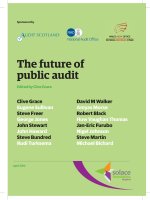The Future of Wireless Banking Implementation of Wireless Banking and Financial Systems
Bạn đang xem bản rút gọn của tài liệu. Xem và tải ngay bản đầy đủ của tài liệu tại đây (241.04 KB, 16 trang )
The Future of Wireless Banking
Implementation of Wireless Banking and Financial Systems
Rod Ghani
Senior Consultant
IBM Global Services
03/15/2001
The Future of Wireless Banking
Ron Ghani
2
Introduction
Have you seen change yet?
Today’s banking and trading institutions realize they must move and move quickly to capitalize on new
business opportunities in wireless banking and trading. Resistance to the implementation of wireless
banking can lead to major losses at the business and market share levels.
Wireless service soon will be a necessity for the end-user. Although many technological barriers need to
be overcome, it is imperative to embrace the change.
Wireless banking and trading is only an extension of the product offerings for the financial institutions. It
is not an extension of web technology, as often perceived.
Online banking and online trading works from standard TCP/IP connection to the Internet using a PC,
while wireless applications present a much greater challenge.
Today, wireless banking lacks leadership in enforcing one standard. There are several network standards,
PDA standards, browsing standards, protocol standards…etc.
In the wireless world, airwaves are the only vehicle to send and receive data. Depending on the physical
location- inside or outside of a building, near or far from a tower, in a small town versus a metropolitan
area- quality is highly variable.
Did my order go through?
Non-repudiation is one of the most contesting issues in wireless banking and trading. The user needs to
have proof that the transaction has been executed and confirmed.
Wireless banking is revolutionizing the makeup of every financial and banking institution. It is radically
transforming the services, needs, and expectations of societies across continents, regardless of culture. In
the next twenty-four months and beyond, massive changes will occur in the way we interact with banks
and trading institutions regarding our business and personal finances.
The revolution is driven by the client (end-user) demanding to have the information available
conveniently anytime, anywhere. Immediate access is expected and required.
Change at the institutional level is not an easy task. Adaptability and flexibility are needed when dealing
with a variety of legacy systems, connectivity issues, protocol challenges, and a constant explosion on the
market of new devices. Large institutions are handicapped by their size and have to become aggressive to
keep up with the rapid times.
Today, B2B, B2C, B2G and B2E are recognized to be vertical online markets. Wireless is going to sub-
divide these markets, and new services will emerge targeting new user groups.
Data managers and system developers are expected to offer more effective and efficient methods in data
delivery, anytime, anywhere, using any device, regardless of platform, protocol, browser, service
provider, financial institution, etc.
The Future of Wireless Banking
Ron Ghani
3
A snap shot of the future
• The Gomez Research estimates that the number of people accessing personal account information
online will grow from approximately 8 million in 1998 to nearly 40 million people in 2003. Given the
numbers, banks and other financial providers must realize the opportunity inherent within Internet
and wireless capabilities.
• According to Jupiter Communications, approximately 100 million people in the U.S. will have
wireless non-PC web access by the year 2003, versus 155 million landline access from PCs. This
deduces that non-PC access will grow to 65% of the wireline PC access market within the next three
to four years.
• According to Forrester research, almost 120 million Europeans already use mobile phones,
exchanging more than two billion wireless text messages each month.
• By 2003, Forrester projects 219 million Europeans, or one-third of the population, will be on the
wireless bandwagon. Of the 50 European e-commerce executives interviewed by Forrester, 90
percent plan to launch sites that will be accessible by mobile phones
• Financial products and services provide an ideal setting for Internet delivery. M-Bank is well
positioned to serve this industry with companies such as Wells Fargo and Co. (NYSE:WFC), Bank of
America Corp. (NYSE:BAC), Providian Financial Corp. (NYSE:PVN), MBNA Corp (NYSE:KRB),
and Capital One Financial Corp. (NYSE:COF).
• A major bank reports that over 3 million online banking customers, representing more than 20% of its
checking account customer base that it continues to sign up approximately 130,000 new online
banking customers a month. Also, more than 750,000 online banking customers have signed up for
the bank's electronic billing and payment service, says the institution, and the total dollar value of
payments processed grew 36% last year. Over 3.1 million EBPP were made, totaling more than $1
billion.
• "It took us over 10 years to reach two million online banking customers and only nine months to add
one million more," says Jeanine Brown, Interactive Banking executive.
• GartnerGroup predicts that by 2004, 80 percent of new applications for consumer use will permit
access from mobile device clients (Source: GartnerGroup conference 1999).
• GartnerGroup research estimates there are more than 60 million employees worldwide working
outside the traditional office setting. The Gartner study also says that the number will grow to 108
million by 2002.
Users Interest in Phones with E-Mail
Current
Users
Potential
Users
Definitely Interested 8.3% 13%
Probably Interested 8.0% 13%
Maybe Interested 13.3% 23%
Probably Not Interested 25% 26%
Definitely Not Interested 45% 25%
Source: The Strategis Group
The Future of Wireless Banking
Ron Ghani
4
Little G History
1G is the first generation in mobile technology. Started in the late 1970s until the late 1980s.
2G began in the 1990s and it is still being used today, such as CDPD, CDMA, and GSM.
3G is the third-generation of wireless. It is expected to reach maturity between the years 2003 and 2005.
3G is expected to delver enhanced voice and data and even video. It is bandwidth can be as high as 2
Mbps and will operate at 2 GHz.
Will Wireless banking play a major role in new markets?
P2P (Person to Person), and P2A (Person to Anyone) will play a major role in the financial world. We
will witness an abundant in money transfers. A user can make a payment, have it automatically deducted
from the appropriate account, and deposited into the recipient account, with an email acknowledgement.
It’s about time
Time is the essence. Wireless banking and trading advantages are increasing by the day due to a rapid
advancement in technology, rapid growth in wireless coverage, cost reduction in networking, and
improvement in handheld devices, and bandwidth efficiency. Today, we can accomplish far more in
wireless services, where it was not cost justifiable a year ago. With that in mind, WSP (Wireless Service
Providers), corporations, and financial institutions can bank on the growth and take advantage of these
opportunities.
The winners in today’s wireless world are those who keep up with the change, cope with the challenges,
and utilize the products and services offered.
Financial institutions must drive to enhance the systems delivery to create layers of an open system
environment. Those who will use standard protocols will expand and thrive. Successful wireless
implementation is delivered when the end-user can interact with the data easily, securely, and independent
of a network operator or handheld device.
The Future of Wireless Banking
Ron Ghani
5
What are the components of a wireless system?
• Handheld devices
• Connectivity, Coverage, and Gateways
• Middleware processing engine
• Transcoding
• API connection
• Data System Backend system
W
i
r
e
l
e
s
s
A
p
p
l
i
c
a
t
i
o
n
I
n
t
e
r
f
a
c
e
Radio tower
Radio tower
Radio tower
CDMA/CDPD
GSM
TCP/IP to WEB server Registration
Gateway
ALLTEL
Gateway
Sprint
Gateway
ARDIS
TCP/IP
TCP/IP
TCP/IP
L
O
A
D
B
A
L
A
N
C
I
N
G
WEB Server
WebSphere Application
WebSphere Transcoding Pub
Device
ID
DB
Local
Data
Storag
e
Wireless
Application Server
Screen Templates
XSL Stylesheets
Screen template
processor
XSL processor
request processor
The Future of Wireless Banking
Ron Ghani
6
1- Handheld Devices
1. Thin Client devices, Palm, Workpad, Ipaq..
2. Two Way paging devices, like RIM
3. Smart-Phones, WAP phones
4. Others
5. Operating systems is a software program that manages the basic operations of a computer
system.
a. Windows CE:
This is a light version of windows, developed by Microsoft. It is Installed on many of the
PDA devices.
b. Palm OS:
It is developed by 3COM, proprietary platform. It is the most popular OS on the
handheld due to the large market share that the Palm Pilot owns today. It supports some
Java applications.
c. Linux: It is very promising for growth, open source base, Java friendly , very efficient,
and it can be installed on many PDA devices and even on smart-phones
d. EPOC:
Symbian consortium drove the development of this operating system mostly for smart-
phone devices used by Ericsson and Nokia. EPOC is one of the major operating systems
in this market.
Each one of these handheld devices will require certain ways of communicating; they require their own
Gateways to communicate to the application servers. Various sizes of screens create different data and
screen layouts. Different keyboards generate different navigational options and different keys. The
challenge is for the application server to sort out these devices, and send the data in the correct format to
each handheld device.
2- Connectivity, Coverage, and Gateways
In this section, we are going to explore the basic components of the wireless network architecture.
Starting from the end user, the handheld device can be any device that is used to access a local cell tower.
A cell tower is responsible for delivering local geographical coverage in a certain region. The coverage is
divided into hexagonal boundaries.
The cell tower then sends the data to a Base Station. The data is then transferred to a switching center.
The mobile switching center connects all Base Stations. The mobile network system will record, and
identify all of the users information by Home Location Register (HLR), if the user is in the geographical
network. If not, then the Visitor Location Register (VLR) will be tracking the call. This is when you pay
Content
Repository
Rules and Logic
Engine
User
Application
engine
Logic
transform
ation and
additional
services
WEB APPLICATION SERVER
WebSphere
Alert
Services
Gateways
A
P
I
V
L
R
User ID and
Information
Device ID and
Capability
Profile
Security Info
Login History
Application
Server Logs
Click Stream
Data
H
LR
Data Mining and
Business Intelligence
ESN/MIN









